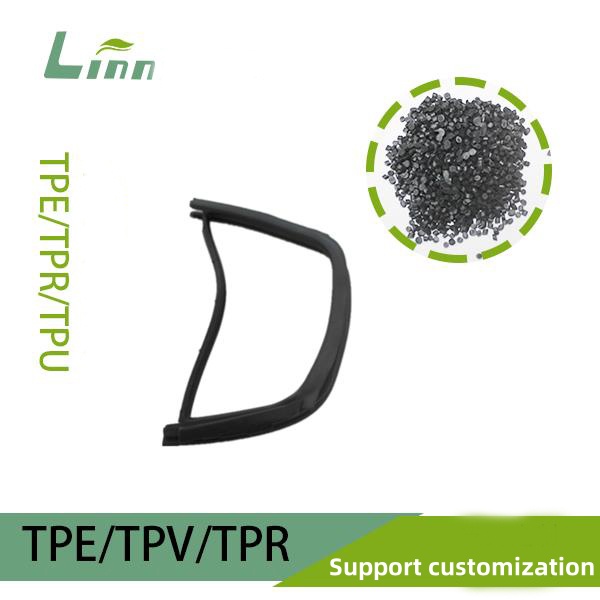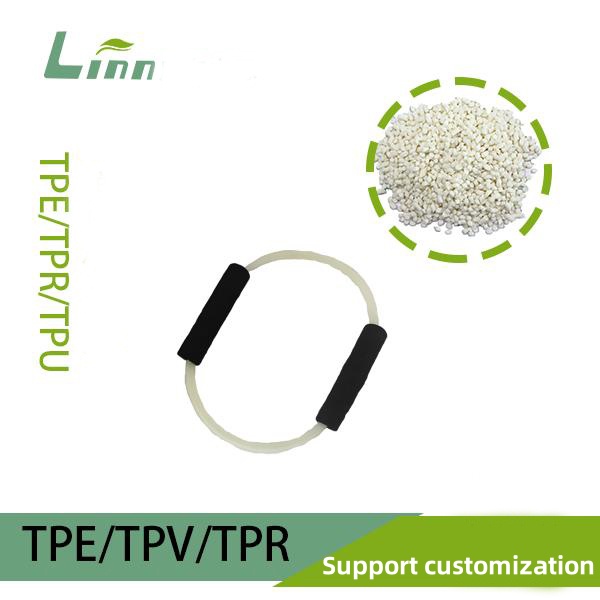As someone who’s been immersed in the field of high-polymer materials for years, I often get questions about thermoplastic elastomers (TPE) processing temperatures, especially: “Why does TPE need such high temperatures?” This question seems straightforward but touches on material properties, processing requirements, and real-world applications. In this article, I’ll dive deep into why TPE processing demands high temperatures, how it impacts product quality and production efficiency, and share practical insights from my experience. My goal is to help you understand this topic thoroughly and apply it effectively.

What Is TPE? A Quick Primer
Before we dive into temperatures, let’s clarify what TPE is. TPE, or thermoplastic elastomer, is a high-polymer material that combines the elasticity of rubber with the processability of plastic. It’s soft and flexible like rubber at room temperature but can be melted and molded like plastic when heated. You encounter TPE everywhere—think phone cases, sealing strips, medical devices, or even sneaker soles.
The magic of TPE lies in its molecular structure: it typically consists of hard segments (like polystyrene or polyester) and soft segments (like polyether or polyolefin). This structure gives TPE its elasticity at room temperature and flowability at high temperatures, making it ideal for molding. But this same structure also makes TPE highly sensitive to temperature, requiring careful control during processing.
Why Does TPE Processing Require High Temperatures?
Now, let’s tackle the core question: why does TPE need high processing temperatures? Based on my experience, here are the key reasons, broken down step by step.

1. Ensuring Complete Melting for Smooth Flow
TPE processing temperatures typically range from 150°C to 250°C, depending on the type (e.g., SBS, SEBS, TPU) and formulation. Why so hot? Simple: TPE needs to fully melt into a flowable liquid to fill every nook and cranny of a mold.
Think of it like baking a cake—if the batter is too thick, the cake comes out uneven. Similarly, if TPE isn’t hot enough, it won’t melt completely, leading to poor flowability. This can cause surface defects like flow marks, bubbles, or even uneven internal structures, compromising strength and elasticity.
I recall a factory troubleshooting session where a client, trying to save energy, lowered the injection molding temperature by 10°C. The result? Rough surfaces and jagged edges on the product. Once we restored the recommended temperature, the issues vanished. So, the right temperature is the foundation for good material flow.
2. Molecular Chain Relaxation for Better Molding
TPE’s molecular chains are “coiled” at room temperature, giving it elasticity. During processing, high temperatures allow these chains to “unravel” and flow. This requires enough heat to overcome intermolecular forces.
If you’re familiar with high-polymer concepts like glass transition temperature (Tg) and melting temperature (Tm), you’ll know that TPE’s hard and soft segments behave differently at various temperatures. The processing temperature must exceed the material’s melting point to fully blend these segments, ensuring the molded product’s mechanical properties and surface quality.
For instance, I worked with a client producing TPE sealing strips. Initially, low temperatures caused the strips to crack in cold environments. We found that insufficient heat left the molecular chains partially coiled, creating internal stresses. Raising the temperature improved the strips’ flexibility and durability significantly.

3. Meeting Demands of Complex Molds and Processes
Modern TPE products are increasingly intricate—think multilayer co-extrusion, thin-walled structures, or parts with embedded metal inserts. These designs demand excellent material flow, which high temperatures enable.
Take injection molding as an example. Molds often have precise runners and cavities. If TPE’s flowability is poor, it can lead to incomplete filling, material shortages, or even mold damage. I once saw a case where a client designed an ultra-thin TPE film, just 0.5mm thick. Low temperatures caused the material to “freeze” in the mold, slowing production and wasting material. Optimizing the temperature curve solved the issue.
4. Balancing Degradation and Performance
You might wonder: won’t high temperatures degrade TPE and harm its properties? It’s a valid concern. Excessive heat can cause thermal degradation, breaking molecular chains and making the material brittle or discolored. That’s why processing temperatures aren’t “the higher, the better”—they need to stay within a reasonable range.
Typically, TPE’s processing temperature depends on its formulation (e.g., presence of plasticizers or fillers). The technical data sheet (TDS) provided by suppliers is your best guide, specifying recommended temperature ranges. My advice? Stick to the TDS, tweak as needed, but don’t stray too far.

Factors Influencing TPE Processing Temperatures
So, what determines the right temperature for TPE? I’ve compiled a table to break it down clearly.
| Factor | Impact Description | Solutions |
|---|---|---|
| TPE Type | Different types (e.g., SBS, SEBS, TPU) have varying melting points; TPU often needs higher temperatures. | Refer to the supplier’s TDS for the appropriate temperature range. |
| Formulation Additives | Plasticizers or fillers (e.g., calcium carbonate) alter flowability, affecting required temperatures. | Adjust temperature based on formulation; consult the supplier if needed. |
| Mold Design | Complex molds demand better flow, requiring higher temperatures. | Coordinate with mold designers to match temperature to mold requirements. |
| Processing Method | Injection molding, extrusion, or blow molding have different needs; extrusion often requires higher temperatures for continuity. | Optimize temperature profiles for the specific process. |
| Environmental Factors | Workshop temperature or humidity can indirectly affect material preheating and processing stability. | Maintain consistent workshop conditions; preheat TPE pellets if necessary. |
This table is just a starting point—real-world adjustments depend on your equipment and product specifics.
How to Set TPE Processing Temperatures Correctly
Now, let’s get practical: how do you nail the right temperature? Here are my go-to tips from years of hands-on work.
1. Start with the Technical Data Sheet (TDS)
Every TPE grade has a recommended processing temperature range, detailed in the supplier’s TDS. For example, an SEBS-based TPE might suggest 180°C-220°C for injection molding, while TPU might need 200°C-240°C. I usually start with the midpoint of the range and fine-tune based on results.
2. Use Segmented Temperature Control
Processing isn’t a one-size-fits-all temperature setting. I prefer dividing the heating zones, especially for injection molding or extrusion:
Feed Zone: Lower temperature to prevent premature melting and clogging.
Compression Zone: Gradually increase temperature for uniform melting.
Metering Zone and Nozzle: Highest temperature for optimal flow.
For extrusion, I might set a rising profile, like 160°C-180°C-200°C from feed to die, ensuring gradual melting and minimizing bubbles or degradation.

3. Monitor Product Quality and Adjust
Temperatures aren’t set in stone. I always check the product’s appearance and performance for clues:
Flow marks or bubbles: Temperature may be too low; increase slightly.
Yellowing or discoloration: Temperature too high, risking degradation.
Dimensional instability: Temperature fluctuations; check equipment stability.
I once debugged a new machine where parts kept varying in size. The culprit? A temperature control system fluctuating by ±10°C. Switching to a more precise controller fixed it.
4. Stay in Touch with Suppliers
TPE formulations vary widely, even within the same brand across batches. If issues arise, I reach out to the supplier—they often have tailored advice.
Precautions for High-Temperature Processing
High temperatures boost TPE quality but come with challenges. Here’s what to watch for:
Safety First: Always wear protective gloves and face shields around hot equipment to avoid burns.
Good Ventilation: TPE may release minor volatile gases at high temperatures, so ensure proper workshop airflow.
Equipment Maintenance: Regularly inspect heating systems and molds to prevent temperature spikes or wear.
Energy Management: High-temperature processing consumes power; optimize cycle times to save energy.

Real-World Case Studies on TPE Temperature
To make this more tangible, let me share two stories from my work.
Case 1: Medical Catheter Clarity Issues
A few years back, I helped a medical device manufacturer improve their TPE catheters, which needed high transparency and flexibility. Early samples looked foggy, like they were veiled in mist. We traced it to a low injection temperature of 170°C, which didn’t fully melt the material. Raising it to 200°C and tweaking cooling times produced crystal-clear catheters that thrilled the client.
Case 2: Automotive Sealing Strip Durability
Another client made TPE sealing strips for cars, but the strips hardened and cracked in cold northern winters. Analysis showed that low extrusion temperatures left molecular chains misaligned, causing internal stress. We bumped the temperature to 220°C and extended the cooling phase, boosting low-temperature performance by over 30%.
These cases cemented my belief that temperature control is the heart of TPE processing, directly shaping a product’s success.

Frequently Asked Questions
To round things out, here are answers to common TPE temperature questions, based on my experience.
1. Can I lower TPE processing temperatures freely?
Not advisable. Low temperatures reduce flowability, leading to defects like incomplete filling or rough surfaces. For energy savings, optimize mold design or cycle times, but keep temperatures within the recommended range.
2. What happens if the temperature is too high?
Excessive heat can degrade TPE, causing discoloration, brittleness, or stronger odors. It may also clog molds, raising maintenance costs. Stick to the TDS to avoid these issues.
3. Are temperature requirements the same for all TPE brands?
No. Each brand’s formulation differs, and temperatures can vary by 10-20°C. Always check the TDS for your specific TPE grade or consult the supplier.
4. How do I know if the temperature is right?
Look at the product: smooth surfaces, no bubbles, and stable dimensions indicate a good setting. If issues like flow marks or discoloration appear, adjust based on the symptoms.
5. Does TPE processing demand specialized equipment?
TPE isn’t overly picky, but stable temperature control and clean molds are crucial. For precision products, equipment accuracy makes a big difference.
Final Thoughts
Why does TPE require high processing temperatures? At its core, it’s about enabling the material to flow, mold, and perform at its best while ensuring quality and consistency. As someone in the field, I’ve seen firsthand how temperature control can make or break a product. I hope this article sheds light on the nuances of TPE processing and helps you avoid common pitfalls.
If you have more questions about TPE—whether it’s processing, formulations, or equipment—feel free to reach out. I’m happy to share what I’ve learned. After all, in the world of high-polymer materials, we’re all exploring together.




